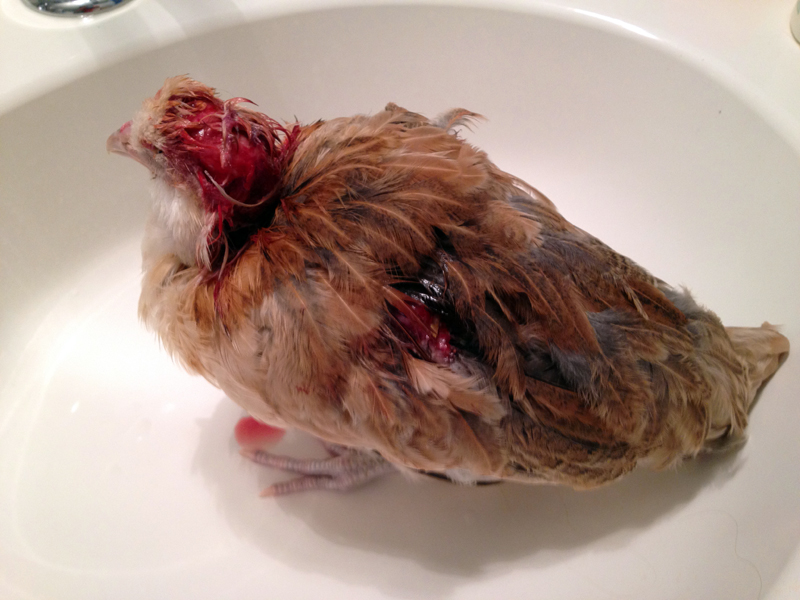Suffice it to say that integrating my youngest birds into the flock didn’t go well.
To back up, in early June, after I got rid of the guineas, I bought a bunch of chicks from a breeder near Richmond. I was really going for her Wheaten Ameraucanas, which lay a turquoise blue egg. But she had some Black Copper Marans and beautiful Lavender Orpingons and threw a Barred Olive Egger in the mix. All would have been well but the Ameraucanas were a couple of weeks younger than the others. Though the breeder said they’d all be okay together, it wasn’t until the Ameraucanas started dying of malnutrition that I realized the older birds were outcompeting them for food.
So I separated the bunches, put the older birds in the coop and the Ameraucanas in a coop in the garage. I had three cockrels and one pullet—already not good odds for blue eggs. Yesterday I put the Ameraucanas into the coop with the older birds, and Lilac and Iris, and watched them very closely. Chickens are known for attacking interlopers, and I was wary. But the young birds seemed to be holding their own, even standing up to Lilac in battle. I checked them first thing this morning, and every couple of hours through the day. I know that adding new chickens to a flock is fraught with peril, which was why I was so reluctant to split the babies up in the first place.
Then around two today I checked again and found my Ameraucana pullet missing most of her head and neck. She’s a pulpy mess, pecked down to the membrane surrounding her skull and wounded again on her back. The cockerels are also all injured, though none as much as the pullet, and she’s the only one I was planning to keep.
I snatched the four young ones out of the big coop and moved them back into their garage coop, and carried the pullet inside. Her blood ran through my fingers as I tried to page through my chicken book one-handed, searching for first-aid advice. I didn’t want to wash her wounds because they were so extensive and I feared that if they started bleeding again I’d lose her. She was in shock, and when I set her in the sink to squirt her with Bactine her eyes closed and her body deflated like a balloon and I thought I was watching her die.
I picked her up, knowing that the more handling I did of her in this state the worse it would be, and returned her to her brothers, who all got Bactine showers. They are all resting now, drinking water. I expected the pullet to be dead this afternoon, but at last check she was alive. Here’s hoping she pulls through though I don’t have high hopes.
All this despite trying my best to be cautious about this move. At least I am not surprised. But what gets me is that in the recent fetishization of chicken keeping, no one mentions days like these. It’s all tweely decorated pastel-colored coops and sweet little names for “the girls,” and yet, here we are. The girls are brutal, the boys are fierce, and between the blood and the shit and the flies there’s rarely much that’s pretty about it. I am tired of the propaganda, such as last week’s piece in the New York Times, “Tour de Cluck Boomlet, a Survey of Chicken Coops,” that paints only the positive side of keeping chickens.
There’s a dark side, but in mainstream media no one is talking about it.

